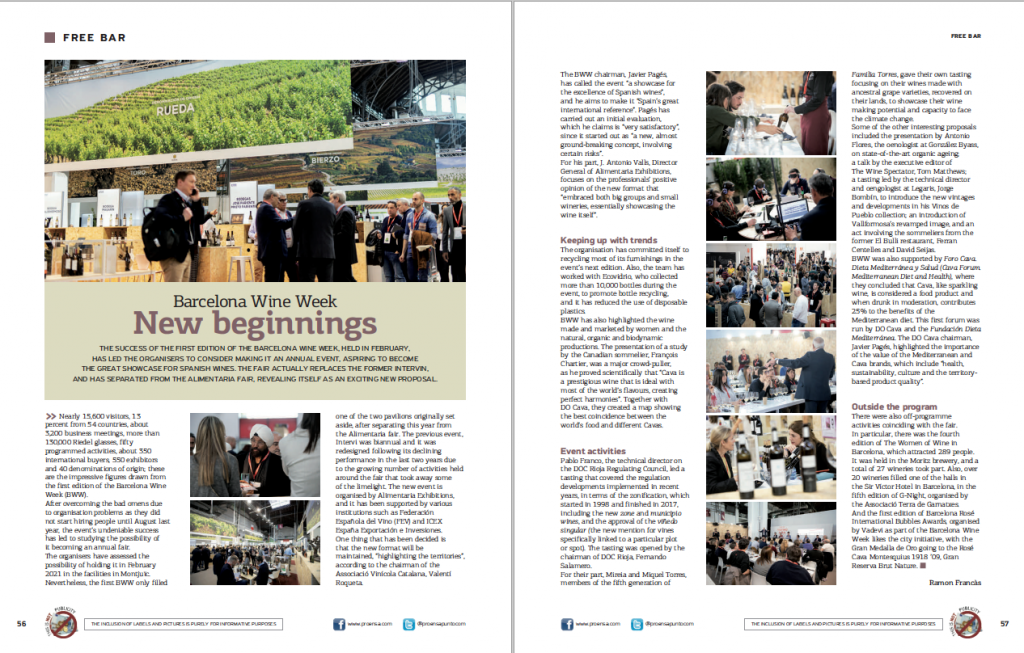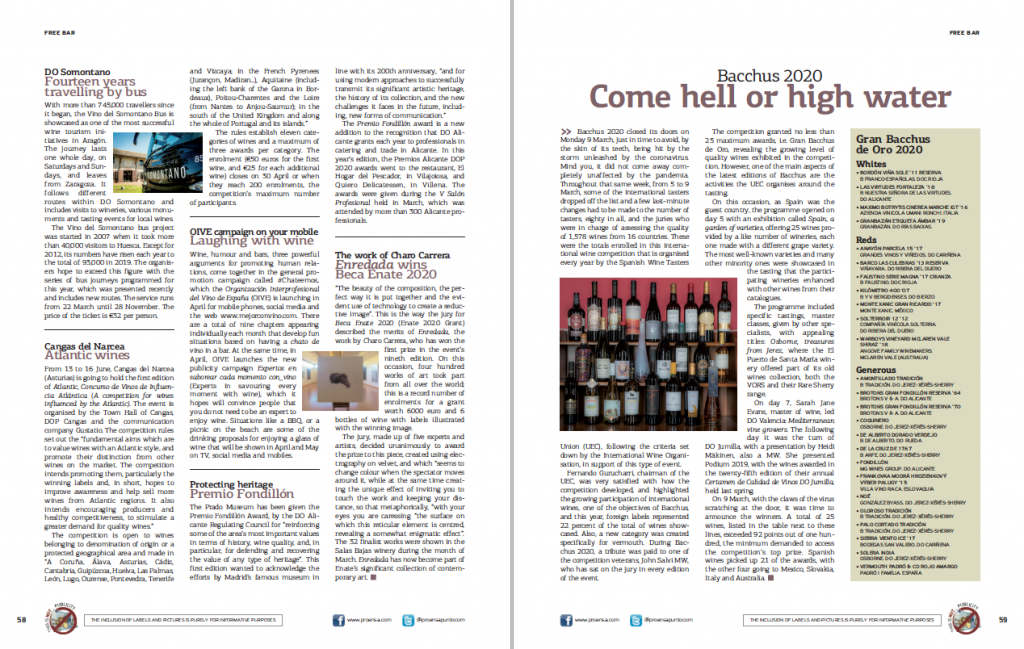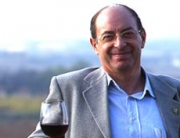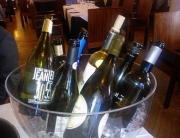The success of the first edition of the Barcelona Wine Week, held in February, has led the organisers to consider making it an annual event, aspiring to become the great showcase for Spanish wines. The fair actually replaces the former Intervin, and has separated from the Alimentaria fair, revealing itself as an exciting new proposal.
Nearly 15,600 visitors, 13 percent from 54 countries, about 3,200 business meetings, more than 130,000 Riedel glasses, fifty programmed activities, about 350 international buyers, 550 exhibitors and 40 denominations of origin; these are the impressive figures drawn from the first edition of the Barcelona Wine Week (BWW).
After overcoming the bad omens due to organisation problems as they did not start hiring people until August last year, the event’s undeniable success has led to studying the possibility of it becoming an annual fair. The organisers have assessed the possibility of holding it in February 2021 in the facilities in Montjuïc.
Nevertheless, the first BWW only filled one of the two pavilions originally set aside, after separating this year from the Alimentaria fair. The previous event, Intervi was biannual and it was redesigned following its declining performance in the last two years due to the growing number of activities held around the fair that took away some of the limelight. The new event is organised by Alimentaria Exhibitions, and it has been supported by various institutions such as Federación Española del Vino (FEV) and ICEX España Exportación e Inversiones. One thing that has been decided is that the new format will be maintained, “highlighting the territories “, according to the chairman of the Associació Vinícola Catalana, Valentí Roqueta.
The BWW chairman of BWW, Javier Pagés, has called the event “a showcase for the excellence of Spanish wines”, and he aims to make it “Spain’s great international reference”. Pagés has carried out an initial evaluation, which he claims is “very satisfactory”, since it started out as “a new, almost ground-breaking concept, involving certain risks”.
For his part, J. Antonio Valls, Director General of Alimentaria Exhibitions, focuses on the professionals’ positive opinion of the new format that “embraced both big groups and small wineries, essentially showcasing the wine itself”.
Keeping up with trends
The organisation has committed itself to recycling most of its furnishings in the event’s next edition. Also, the team has worked with Ecovidrio, who collected more than 10,000 bottles during the event, to promote bottle recycling, and it has reduced the use of disposable plastics.
BWW has also highlighted the wine made and marketed by women and the natural, organic and biodynamic productions. The presentation of a study by the Canadian sommelier, François Chartier, was a major crowd-puller, as he proved scientifically that “Cava is a prestigious wine that is ideal with most of the world’s flavours, creating perfect harmonies”. Together with DO Cava, they created a map showing the best coincidence between the world’s food and different Cavas.
Event activities
Pablo Franco, the technical director on the DOC Rioja Regulating Council, led a tasting that covered the regulation developments implemented in recent years, in terms of the zonification, which started in 1998 and finished in 2017, including the new zone and municipio wines, and the approval of the viñedo singular (the new mention for vines specifically linked to a particular plot or spot). The tasting was opened by the chairman of DOC Rioja, Fernando Salamero.
For their part, Mireia and Miquel Torres, members of the fifth generation of Familia Torres, gave their own tasting focusing on their wines made with ancestral grape varieties, recovered on their lands, to showcase their wine making potential and capacity to face the climate change.
Some of the other interesting proposals included the presentation by Antonio Flores, the oenologist at González Byass, on state-of-the-art organic ageing; a talk by the executive editor of The Wine Spectator, Tom Matthews; a tasting led by the technical director and oengologist at Legaris, Jorge Bombín, to introduce the new vintages and developments in his Vinos de Pueblo collection; an introduction of Vallformosa’s revamped image, and an act involving the sommeliers from the former El Bulli restaurant, Ferran Centelles and David Seijas.
BWW was also supported by Foro Cava. Dieta Mediterránea y Salud (Cava Forum. Mediterranean Diet and Health), where they concluded that Cava, like sparkling wine, is considered a food product and when drunk in moderation, contributes 25% to the benefits of the Mediterranean diet. This first forum was run by DO Cava and the Fundación Dieta Mediterránea. The DO Cava chairman, Javier Pagés, highlighted the importance of the value of the Mediterranean and Cava brands, which include “health, sustainability, culture and the territory-based product quality”.
Outside the program
There were also off-programme activities coinciding with the fair. In particular, there was the fourth edition of The Women of Wine in Barcelona, which attracted 289 people. It was held in the Moritz brewery, and a total of 27 wineries took part. Also, over 20 wineries filled one of the halls in the Sir Víctor Hotel in Barcelona, in the fifth edition of G-Night, organised by the Associació Terra de Garnatxes. And the first edition of Barcelona Rosé International Bubbles Awards, organised by Vadevi as part of the Barcelona Wine Week likes the city initiative, with the Gran Medalla de Oro going to the Rosé Cava Montesquius 1918 ’09, Gran Reserva Brut Nature.
Ramon Francàs
DO Somontano
Fourteen years travelling by bus
With more than 745,000 travellers since it began, the Vino del Somontano Bus is showcased as one of the most successful wine tourism initiatives in Aragón. The journey lasts one whole day, on Saturdays and Sundays, and leaves from Zaragoza. It follows different routes within DO Somontano and includes visits to wineries, various monuments and tasting events for local wines.
The Vino del Somontano bus project was started in 2007 when it took more than 40,000 visitors to Huesca. Except for 2012, its numbers have risen each year to the total of 93,000 in 2019. The organisers hope to exceed this figure with the series of bus journeys programmed for this year, which was presented recently and includes new routes. The service runs from 22 March until 28 November. The price of the ticket is €32 per person.
OIVE campaign on your mobile
Laughing with wine
Wine, humour and bars, three powerful arguments for promoting human relations, come together in the general promotion campaign called #Chateemos, which the Organización Interprofesional del Vino de España (OIVE) is launching in April for mobile phones, social media and the web www.mejorconvino.com. There are a total of nine chapters appearing individually each month that develop fun situations based on having a chato de vino in a bar. At the same time, in April, OIVE launches the new publicity campaign Expertos en saborear cada momento con_vino (Experts in savouring every moment with wine), which it hopes will convince people that you do not need to be an expert to enjoy wine. Situations like a BBQ, or a picnic on the beach are some of the drinking proposals for enjoying a glass of wine that will be shown in April and May on TV, social media and mobiles.
Competition in Cangas del Narcea
Atlantic wines
From 13 to 16 June, Cangas del Narcea (Asturias) is going to hold the first edition of Atlantic, Concurso de Vinos de Influencia Atlántica (A competition for wines influenced by the Atlantic). The event is organised by the Town Hall of Cangas, DOP Cangas and the communication company Gustatio. The competition rules set out the “fundamental aims which are to value wines with an Atlantic style, and promote their distinction from other wines on the market. The competition intends promoting them, particularly the winning labels and, in short, hopes to improve awareness and help sell more wines from Atlantic regions. It also intends encouraging producers and healthy competitiveness, to stimulate a greater demand for quality wines.”
The competition is open to wines belonging to denomination of origin or a protected geographical area and made in “A Coruña,
Álava, Asturias, Cádiz, Cantabria, Guipúzcoa, Huelva, Las Palmas, León, Lugo, Ourense, Pontevedra, Tenerife and Vizcaya; in the French Pyrenees (Jurançon, Madiran…), Aquitaine (including the left bank of the Garona in Bordeaux), Poitou-Charentes and the Loire (from Nantes to Anjou-Saumur); in the south of the United Kingdom and along the whole of Portugal and its islands.”
The rules establish eleven categories of wines and a maximum of three awards per category. The enrolment (€50 euros for the first wine, and €25 for each additional wine) closes on 30 April or when they reach 200 enrolments, the competition’s maximum number of participants.
Protecting heritage
Premio Fondillón
The Prado Museum has been given the Premio Fondillón Award, by the DO Alicante Regulating Council for “reinforcing some of the area’s most important values in terms of history, wine quality, and, in particular, for defending and recovering the value of any type of heritage”. This first edition wanted to acknowledge the efforts by Madrid’s famous museum in line with its 200th anniversary, “and for using modern approaches to successfully transmit its significant artistic heritage, the history of its collection, and the new challenges it faces in the future, including, new forms of communication.”
The Premio Fondillón award is a new addition to the recognition that DO Alicante grants each year to professionals in catering and trade in Alicante. In this year’s edition, the Premios Alicante DOP 2020 awards went to the restaurant, El Hogar del Pescador, in Vilajoiosa, and Quiero Delicatessen, in Villena. The awards were given during the V Salón Profesional held in March, which was attended by more than 300 Alicante professionals.
The work of Charo Carrera
Enredada wins Beca Enate 2020
“The beauty of the composition, the perfect way it is put together and the evident use of technology to create a seductive image”. This is the way the jury for Beca Enate 2020 (Enate 2020 Grant) described the merits of Enredada, the work by Charo Carrera, who has won the first prize in the event’s nineth edition. On this occasion, four hundred works of art took part from all over the world; this is a record number of enrolments for a grant worth 6000 euro and 6 bottles of wine with labels illustrated with the winning image.
The jury, made up of five experts and artists, decided unanimously to award the prize to this piece, created using electrography on velvet, and which “seems to change colour when the spectator moves around it, while at the same time creating the unique effect of inviting you to touch the work and keeping your distance, so that metaphorically, “with your eyes you are caressing “the surface on which this reticular element is centred, revealing a somewhat enigmatic effect”. The 32 finalist works were shown in the Salas Bajas winery during the month of March. Enredada has now become part of Enate’s significant collection of contemporary art.
Bacchus 2020
Come hell or high water
>> Bacchus 2020 closed its doors on Monday 9 March, just in time to avoid, by the skin of its teeth, being hit by the storm unleashed by the coronavirus. Mind you, it did not come away completely unaffected by the pandemia. Throughout that same week, from 5 to 9 March, some of the international tasters dropped off the list and a few last-minute changes had to be made to the number of tasters, eighty in all, and the juries who were in charge of assessing the quality of 1,578 wines from 16 countries. These were the totals enrolled in this international wine competition that is organised every year by the Spanish Wine Tasters Union (UEC), following the criteria set down by the International Wine Organisation, in support of this type of event.
Fernando Gurucharri, chairman of the UEC, was very satisfied with how the competition developed, and highlighted the growing participation of international wines, one of the objectives of Bacchus, and this year, foreign labels represented 22 percent of the total of wines showcased. Also, a new category was created specifically for vermouth. During Bacchus 2020, a tribute was paid to one of the competition veterans, John Salvi MW, who has sat on the jury in every edition of the event.
The competition granted no less than 25 maximum awards, i.e. Gran Bacchus de Oro, revealing the growing level of quality wines exhibited in the competition. However, one of the main aspects of the latest editions of Bacchus are the activities the UEC organises around the tasting. On this occasion, as Spain was the guest country, the programme opened on day 5 with an exhibition called Spain, a garden of varieties, offering 25 wines provided by a like number of wineries, each one made with a different grape variety. The most well-known varieties and many other minority ones were showcased in the tasting libre that the participating wineries enhanced with other wines from their catalogues.
The programme included specific tastings, master classes, given by other specialists, with appealing titles: Osborne, treasures from Jerez, where the El Puerto de Santa María winery offered part of its old wines collection, both the VORS and their Rare Sherry range.
On day 7, Sarah Jane Evans, master of wine, led DO Valencia: Mediterranean vine growers. The following day it was the turn of DO Jumilla, with a presentation by Heidi Mäkinen, also a MW. She presented Podium 2019, with the wines awarded in the twenty-fifth edition of their annual Certamen de Calidad de Vinos DO Jumilla, held last spring.
On 9 March, with the claws of the virus scratching at the door, it was time to announce the winners. A total of 25 wines, listed in the table next to these lines, exceeded 92 points out of one hundred, the minimum demanded to access the competition’s top prize. Spanish wines picked up 21 of the awards, with the other four going to Mexico, Slovakia, Italy and Australia.





Deje su comentario
Debe estar logged in para comentar.